Physics Electromagnetic Induction Class 12 Notes: The 6th Chapter of CBSE Class 12 Physics covers importance of electromagnetic induction. Initially, electricity and magnetism were considered separate, but Oersted, Ampere, and others conducted experiments that revealed their interconnected nature. Faraday and Henry conducted experiments in the 1830s, demonstrating that changing magnetic fields could induce electric currents in closed coils. This breakthrough led to the development of generators and transformers, revolutionizing technology and paving the way for electricity, lights, trains, telephones, and computers, thus significantly shaping modern civilisation. In this article, we will explore various essential topics discussed in this chapter, including the aforementioned experiments, magnetic flux, inductance, AC generator, and more. These concepts are crucial for scoring well in the 12th class Physics CBSE Board exams in 2024.
Related:
Also Check:
CBSE 12th Physics Chapter 6 Electromagnetic Induction Class 12 Notes
6.2 THE EXPERIMENTS OF FARADAY AND HENRY1st Experiment When a North-pole of a bar magnet is moved towards a coil, an electric current is detected by a galvanometer, causing the pointer to deflect. The deflection continues as long as the magnet is in motion. However, there is no deflection in the galvanometer when the magnet is stationary. When the magnet is pulled away from the coil, the galvanometer shows a deflection in the opposite direction, indicating a reversal of the current's direction. The same observations are made when the South-pole of the magnet is moved towards or away from the coil, but with opposite deflections compared to the North-pole's movements. Furthermore, faster movements of the magnet towards or away from the coil result in larger deflections (and currents). Similarly, when the bar magnet is held still and the coil is moved towards or away from the magnet, the same effects are observed. It shows that it is the relative motion between the magnet and the coil that is responsible for generation (induction) of electric current in the coil.
2nd Experiment It is the relative motion between the coils that induces the electric current. 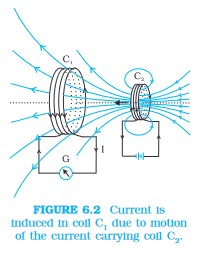 3rd Experiment Relative motion is not an absolute requirement to induce an electric current.
6.3 MAGNETIC FLUXIn Uniform Magnetic Field
In Non-Uniform Magnetic Field
6.4 FARADAY’S LAW OF INDUCTIONAn emf is induced in a coil when magnetic flux through the coil changes with time. Faraday’s law of electromagnetic induction The magnitude of the induced emf in a circuit is equal to the time rate of change of magnetic flux through the circuit.
The negative sign indicates the direction of emf and hence the direction of current in a closed loop. In the case of a closely wound coil of N turns, change of flux associated with each turn, is the same. Therefore, the expression for the total induced emf is given by
6.5 LENZ’S LAW AND CONSERVATION OF ENERGYLenz’s Law: The polarity of induced emf is such that it tends to produce a current which opposes the change in magnetic flux that produced it.
If the induced current were opposite to the one shown in Fig. 6.6(a), a perpetual-motion machine could be constructed, violating the law of conservation of energy. The magnet would be attracted towards the coil with increasing acceleration, leading to perpetual motion without any energy expenditure. However, this is not possible as it violates the fundamental law of energy conservation but in the correct case depicted in Fig. 6.6(a), the induced current creates a repulsive force on the bar magnet. As a result, work needs to be done by a person to move the magnet. The energy spent by the person is dissipated as Joule heating caused by the induced current. This demonstrates the validity of Lenz's law and the conversion of mechanical energy into heat energy during electromagnetic induction. 6.6 MOTIONAL ELECTROMOTIVE FORCE
When the arm PQ is moved to the left side, thus decreasing the area of the rectangular loop, the movement induces a current I, as shown. The induced emf Blv is called motional emf. The work done in moving the charge from P to Q is, W = qvBl Since emf is the work done per unit charge, EMF ε = W/q = Blv In the case of a stationary conductor, the force on its charges is given by F = q (E + v x B) = qE 6.7 INDUCTANCEInductance is the ratio of the flux-linkage to current. An electric current can be induced in a coil by flux change produced by another coil in its vicinity or flux change produced by the same coil.
Inductance is a scalar quantity. The SI unit of inductance is henry and is denoted by H. 6.7.1 Mutual inductance
6.7.2 Self-inductance
6.8 AC GENERATOR
In an ac generator, mechanical energy is converted to electrical energy by virtue of electromagnetic induction. If coil of N turn and area A is rotated at n revolutions per second in a uniform magnetic field B, then the motional emf produced is
where we have assumed that at time t = 0 s, the coil is perpendicular to the field. |
CBSE Electromagnetic Induction Class 12 Notes PDF Download
Download CBSE Class 12 Physics Ch 6 Electromagnetic Induction Notes PDF |
Related:
CBSE Electromagnetic Induction Class 12 Mind Map for Chapter 6 of Physics, Download PDF
Also Check:
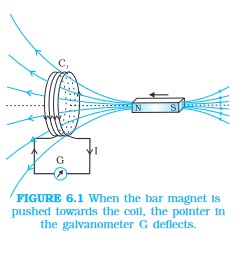


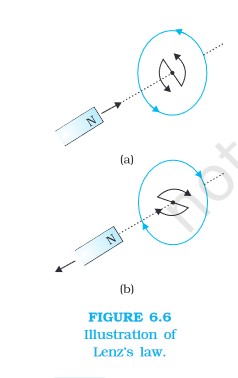
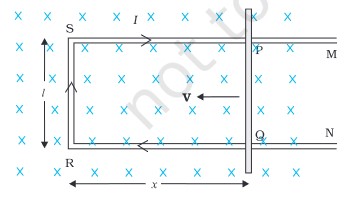


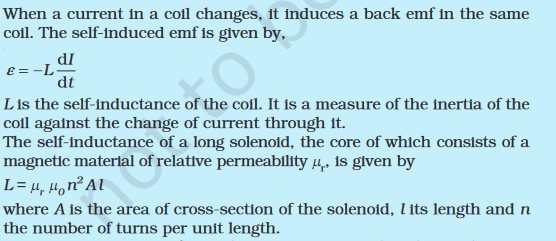
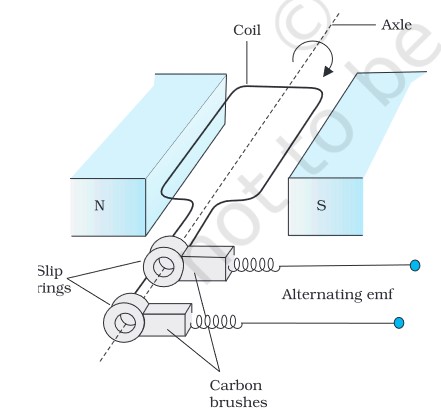
Comments
All Comments (0)
Join the conversation